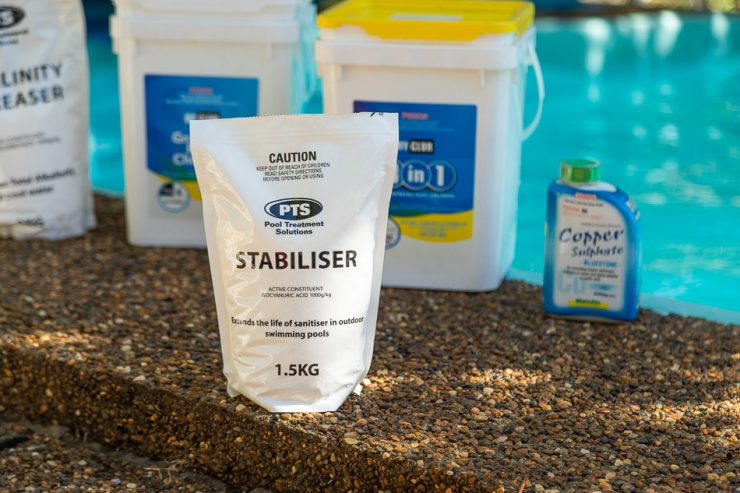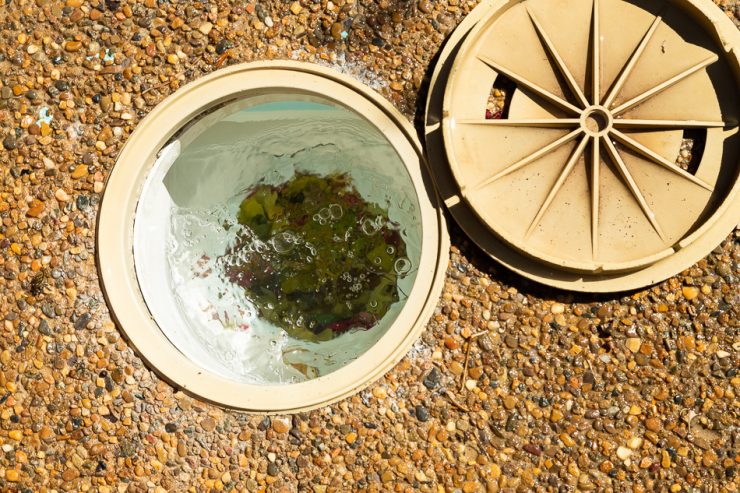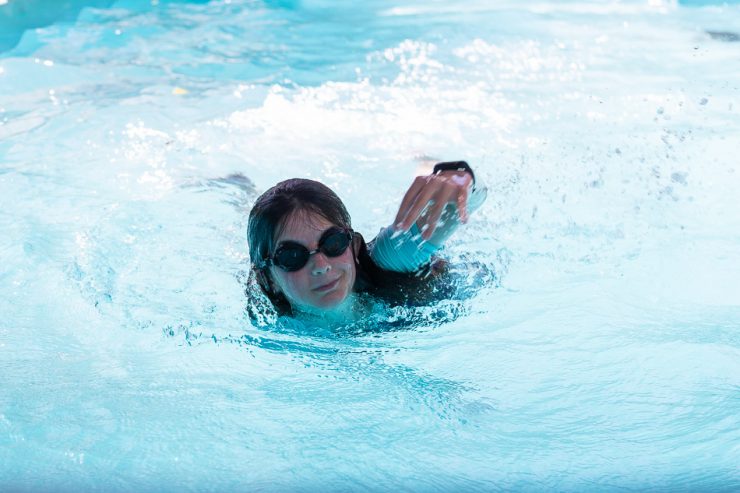Low cyanuric acid in your pool is something you should definitely deal with. Although it doesn’t pose any health risks, not to bother fixing low stabilizer (cyanuric acid) will cost you money.
Cyanuric acid (also known as cya, chlorine stabilizer, pool stabilizer and pool sunscreen) is an essential chemical in your pool that protects your chlorine from dissipating too quickly. Without it, you’ll be spending a heap of money adding buckets of chlorine.
In this article I will show you how to raise cyanuric acid in your pool.
And if you want to know more about pool stabilizer and cyanuric acid, check out our article on what pool stabilizer is here.

Article Contents
How to Raise Cyanuric Acid in Pool
Step 1) Calculate the volume of water in your pool.
Step 2) Calculate the amount of cyanuric acid (stabilizer) you will need.
Generally, you’ll need to add 1lb of cyanuric acid to raise the level by 10ppm per 10,000 gallons of water.
Note: Some cyanuric acids aka pool stabilizer vary so check the instructions on the pack before calculating the amount needed.
A word of caution, it’s far better to add small amounts over time rather than risk adding too much. Once cyanuric acid is in the pool there’s no way to get it out except by draining some water.
Step 3) Add the Cyanuric Acid
If you’re using liquid cyanuric acid, you can pour it directly into the filter box. You can get it here:
- Stabilizes & protects chlorine from UV degradation
- Since it's liquid, it takes effect quickly
- Suitable for pools & outdoor hot tubs

If you’re using granular cyanuric acid (most popular) or the powder form of cyanuric acid, the best way is to put the cya in a skimmer sock first. Then you can either hang it in front of the return jet (use a pool pole) or you can place it in the skimmer box.
Alternatively, you can add cyanuric acid to a bucket of warm water, then pour it into the skimmer box.
The downside to pouring it directly into the skimmer box is that you may find granules on the bottom of your pool floor (which doesn’t feel great on your feet AND it may also damage pool liners). You also won’t be able to backwash your pool until the stabilizer has dissolved (about 2-5 days) – otherwise you risk backwashing the cyanuric acid at the same time.
Step 4) Turn your pump on to the “circulate” or “filter” setting.
For liquid stabilizer, you only need to leave it on for a few hours to mix through.
For granular cyanuric acid, leave the pump on for 48 hours. Then run the pump for a minimum of 4 hours per day for a week (you should be doing this anyway).
Step 5) Retest the water and repeat if necessary.
Note on testing cyanuric acid levels
If you’re using liquid cyanuric acid to raise the cyanuric acid levels, this will mix quickly with the water and raise the levels within a couple of hours.
The granular form may take several days to a week as it takes time to dissolve fully. So don’t get alarmed and add more stabilizer if the levels haven’t gone up straight away. If the stabilizer won’t dissolve, check out our article: How to Dissolve Pool Stabilizer | Stabilizer Not Dissolving
Why is Cyanuric Acid Low?
Unlike other chemicals in your pool, cyanuric acid doesn’t dissipate naturally. Once it’s in your pool, it’s there for good and the only way to get it out is to remove some of the water.
So if it doesn’t go anywhere why is the stabilizer low I hear you ask?
Good question! Low cyanuric is caused by the action of taking water out and topping it up.
Here are the main reasons you may be losing water and needing to top up your pool:
- Rain
- Evapouration
- Splashing
- Pool leaking
It’s not actually when you remove the water that the cyanuric acid levels become low, it’s when you add more water. Topping up the water has a dilution effect and as a result, it will lower the cyanuric acid in your pool.
If you’ve experienced high cyanuric acid level, you may be interested in our article: How to Lower Cyanuric Acid in Pool (Cyanuric Acid Too High)
Is Having Low Cyanuric Acid a Problem?
Chlorine is actually more effective at killing the bad bugs when pool stabilizer is low. The problem with low cyanuric acid is chlorine degrades quickly in the presence of sunlight. Chlorine is rendered completely ineffective within a few hours of sun exposure.
If you didn’t have cyanuric acid in your pool or it was low, you’ll find that you need to add a lot more chlorine to have effective sanitization. So unless you enjoy spending more than you need to on chlorine and like adding chlorine a few times a day, I would suggest you raise chlorine stabilizer levels to the correct level.
Is it Safe to Swim in a Pool With Low Cyanuric Acid?

It is absolutely fine to swim in a pool with low cyanuric acid as long as the chlorine levels have been maintained.
What’s the correct level of chlorine to cyanuric acid?
It’s generally accepted that free chlorine should be about 7.5% of the CYA level.
That is, if your cyanuric acid level is 50ppm, you will need 3.75 ppm (7.5%) of free chlorine for effective sanitization. You can read more about the correct cyanuric acid levels in our article:
Cyanuric Acid for Pools – The Complete Guide for Pool Owners
Do all Pools Need Cyanuric Acid?
No all pools do not need cyanuric acid. Here’s why.
As mentioned above, sunlight degrades chlorine quickly. Pool stabilizer (cyanuric acid) protects the chlorine from this reaction. So only pools that are exposed to UV light need cyanuric acid.
Importantly though, this only applies to chlorinated pools. Pools which are sanitized by alternative systems using ozone & UV do not need cyanuric acid. Cyanuric acid’s sole job is to protect the chlorine.
Which Products Contain Cyanuric Acid?
Another way of raising cyanuric acid levels is to use chlorine products that contain cyanuric acid. These can be marketed as stabilized chlorine. Pool shock products normally have cyanuric acid in them too.
These products that contain cyanuric acid:
- Dichlor
- Trichlor
- Chlorine Shock
- Trichloroisocyanurate
- Sodium Dichloroisocyanurate
- Potassium Dichloroisocyanurate
These will raise cyanuric acid levels but more slowly than adding pure cyanuric acid.
These chlorine products do NOT contain cyanuric acid:
- Liquid Chlorine
- Calcium Hypochlorite (Cal-Hypo)
- Dry chlorine
Summary
In summary, it’s safe to swim in a pool with low cyanuric acid as long as you have the correct levels of free chlorine.
To raise cyanuric acid in your pool, you’ll want to test your water and determine how much you need to raise the stabilizer levels by.
Then calculate the amount of stabilizer to add (read the instructions on the stabilizer package). The best way to add stabilizer is in a skimmer sock or you can mix it in a warm bucket of water and pour it into the skimmer.
Cyanuric acid can take up 5 days to dissolve, so be patient before adding more or you risk overdoing it and ending up with high cyanuric acid.
If you follow these steps, you’ll soon have your pool’s chemistry restored and back to normal levels again.
Happy Swimming!
Recommended Products
Cyanuric Acid – granular form
Cyanuric Acid – liquid form
Related Reading:
Cyanuric Acid for Pools – The Complete Guide for Pool Owners



Evaporation does not lower cya levels. Only H20 leaves the pool.
Yes you’re right.
CYA levels will be reduced if water is removed from the pool by backwashing, draining or splashing AND you top up the pool again. Topping up the water will dilute the CYA thus reducing the concentration in the water.